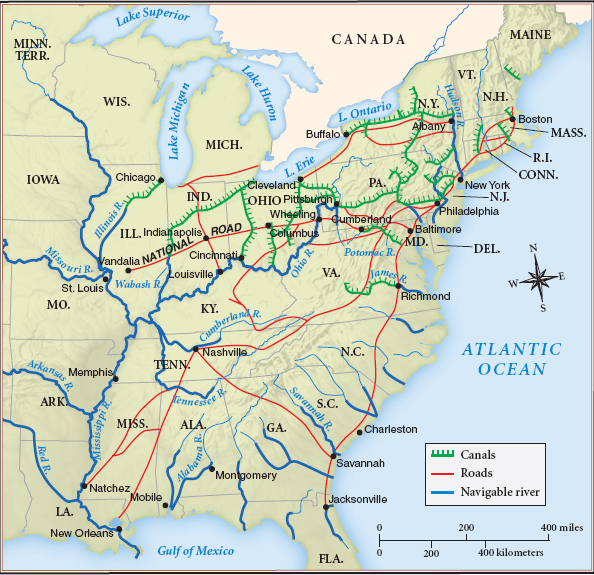AP-Style Short Answer Questions for Part 4
1. Question 1 is based on Map 9.3: The Transportation Revolution: Roads and Canals, 1820-1850.

Use your knowledge of United States history and Map 9.3 to answer parts A, B, and C.
A) Briefly identify and explain ONE way this map illustrates the changes that took place in the U.S. economy between 1820 and 1850.
B) Briefly identify and explain ONE way this map illustrates the changes that took place in the distribution of the American population between 1820 and 1850.
C) Briefly explain the relationship between the factor you identified in part A and the factor you identified in part B.
Question 104.1
2. Use your knowledge of United States history and the excerpt below to answer parts A and B.
It would seem to be humiliating to be under the necessity, in the nineteenth century, of entering into a formal argument to prove the utility, and to free governments, the absolute necessity of education. . . . Such necessity would be degrading to a Christian age and a free republic. If an elective republic is to endure for any great length of time, every elector must have sufficient information, not only to accumulate wealth and take care of his pecuniary concerns, but to direct wisely the Legislatures, the Ambassadors, and the Executive of the nation; for some part of all these things, some agency in approving or disapproving of them, falls to every freeman. If, then, the permanency of our government depends upon such knowledge, it is the duty of government to see that the means of information be diffused to every citizen. This is a sufficient answer to those who deem education a private and not a public duty—who argue that they are willing to educate their own children, but not their neighbor’s children.
Source: Thaddeus Stevens, Speech before the Pennsylvania General Assembly,
February 1835
A) Briefly identify and explain TWO arguments the speaker makes in favor of public education in this excerpt.
B) Briefly explain how ONE of the arguments you identified in part A relates to the political changes that took place in the United States in the 1830s and 1840s.
Question 104.2
3. Use your knowledge of United States history to answer parts A, B, and C.
A) Identify and briefly explain how ONE of the following factors influenced the North between 1800 and 1860:
Benevolent reform
The textile industry
B) Briefly explain how the factor you discussed in part A influenced the South between 1800 and 1860.
C) Briefly explain how the factor you discussed in parts A and B related to ONE of the following issues:
The annexation of Texas
Indian removal
Question 104.3
4. Question 4 is based on the following two passages.
“In towns and cities all over the northern United States, revivals after 1825 were tied closely to the growth of a manufacturing economy. . . . Everywhere enthusiasm struck first among masters and manufacturers, then spread through them into the ranks of labor. . . . Evangelicalism was a middle-class solution to problems of class, legitimacy, and order generated in the early stages of manufacturing. Revivals provided entrepreneurs with a means of imposing new standards of work discipline and personal comportment upon themselves and then men who worked for them, and thus they functioned as powerful social controls. . . . A significant minority of workingmen participated willingly in that process. And that, of course, is the most total and effective social control of all.”
Paul Johnson, A Shopkeepers’ Millennium, 1978
“Traditional moral economy and Democratic politics were being radicalized by a resurgence of working-class militancy that brought the labor movement to its first historic peak in the mid-1830s. . . . Strikes by Baltimore hatters and New York carpenters in 1833 inspired support and organization by other trades, and the old Workey leadership reemerged in the General Trades’ Unions uniting all the trades in more than a dozen cities. . . . A wildfire of mainly successful strikes . . . swept the Northeast between 1833 and 1836. Mounting demands for the ten-hour day culminated in a general strike by some twenty thousand Philadelphia workers. Striking trades got substantial financial support from nonstriking trades . . . [and] a new spirit of class solidarity reached beyond the established trades to back, at least sporadically, unskilled and factory labor, immigrants, and working women.”
Charles Sellers, The Market Revolution, 1991
Using your knowledge of U.S. history and the two excerpts above, answer parts A, B, and C.
A) Explain the major difference between Johnson’s and Sellers’s interpretations of the 1830s.
B) Briefly explain how someone supporting Johnson’s interpretation could use ONE piece of evidence from the period 1800–1860.
C) Briefly explain how someone supporting Sellers’s interpretation could use ONE piece of evidence from the period 1800–1860.